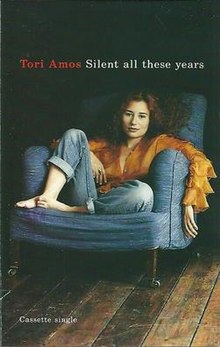Silent All These Years
| "Silent All These Years" | ||||
|---|---|---|---|---|

Standard artwork for 1991 release (U.S. cassette pictured)
|
||||
| Single by Tori Amos | ||||
| from the album Little Earthquakes | ||||
| A-side | "Me and a Gun" | |||
| B-side |
|
|||
| Released | 11 November 1991 (UK) 3 February 1992 (AUS) April 1992 (US) 10 August 1992 (UK re-issue) 17 August 1992 (UK limited edition) |
|||
| Label | Atlantic, EastWest | |||
| Writer(s) | Tori Amos | |||
| Producer(s) | Tori Amos, Eric Rosse | |||
| Tori Amos singles chronology | ||||
|
||||
"Silent All These Years" is a song by American singer-songwriter and musician Tori Amos. It was released as the second single from her debut studio album Little Earthquakes. It was originally released in November 1991 in the UK by EastWest Records. It was released in North America in April 1992 by Atlantic Records and was later used to promote awareness of the Rape, Abuse & Incest National Network (RAINN). In the UK the single was re-released on August 10, 1992.
"Silent All These Years" was written during Amos's search for self (and solo album material) after the failure of Y Kant Tori Read. According to her narrative during VH1 Storytellers, she originally wrote this song with Al Stewart in mind to sing it, and Eric Rosse, who was producing some other songs Amos had composed, heard it and told her, "You're out of your mind. That's your life story"; as a result, Amos retained it as her own recording.
In the Little Earthquakes songbook, Amos reveals that writing the song was a slow, evolving process and that the light piano riff during the verses came first. This "bumble bee piano tinkle," as she calls it, is one of the more emblematic and recognizable parts of the song.
Lyrically, Amos was inspired by reading Hans Christian Andersen's The Little Mermaid story to her little niece, Cody.
The video for "Silent All These Years" was the first of Amos's solo career. It was shot by Cindy Palmano over the course of two days.
Palmano, who had been a stills photographer until this project, came up with the idea of Amos rolling inside a box, the image which is most often associated with the video. Other clips include impersonal shots of objects such as false breasts on a clothes hanger and flowing honey, which Palmano describes as having "a modern look, very clean." The video approaches a climax with shots of Amos twirling against an uneven surface, created by using a corner of a room painted such a crisp white that it's hard to tell that the wall is even there at all. For the final seconds, Amos's face fills the frame as she simply sings to the camera.
...
Wikipedia
